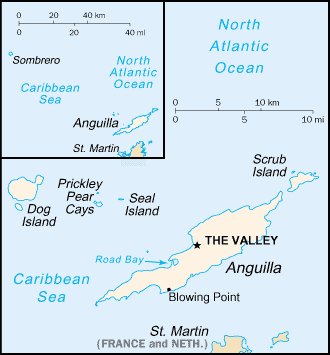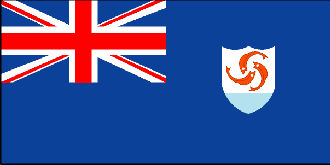
|
Anguilla
Background:
Colonized by English settlers from Saint Kitts in 1650, Anguilla
was administered by Great Britain until the early 19th century, when the
island - against the wishes of the inhabitants - was incorporated into a
single British dependency along with Saint Kitts and Nevis. Several
attempts at separation failed. In 1971, two years after a revolt,
Anguilla was finally allowed to secede; this arrangement was formally
recognized in 1980 with Anguilla becoming a separate British dependency.
Location:
Caribbean, island in the Caribbean Sea, east of Puerto Rico
Area: Total: 91 sq km.
Area - comparative: About half the size
of Washington, DC
Coastline: 61 km.
Climate and Terrain:
Tropical; moderated by northeast trade winds. Flat and low-lying island
of coral and limestone. Elevation extremes: Lowest point: Caribbean Sea
0 m, highest point: Crocus Hill 65 m. Natural resources: Salt, fish, lobster.
Land use: Arable land: 0%, forests and woodland: 0%, other: 100% (mostly
rock with sparse scrub oak, few trees, some commercial salt ponds).
People:
Population: 12,132.
Ethnic groups: Black.
Religions: Anglican
40%, Methodist 33%, Seventh-Day Adventist 7%, Baptist 5%,
Roman Catholic
3%, other 12%.
Languages: English.
Government:
Overseas territory of the UK.
Capital: The Valley.
Economy overview:
Anguilla has few natural resources, and the economy depends
heavily on
luxury tourism, offshore banking, lobster fishing, and remittances
from
emigrants. The economy, and especially the tourism sector, suffered
a
setback in late 1995 due to the effects of Hurricane Luis in September
but
recovered in 1996. Increased activity in the tourism industry, which
has
spurred the growth of the construction sector, has contributed to
economic
growth. Anguillan officials have put substantial effort into
developing the
offshore financial sector. A comprehensive package of
financial services
legislation was enacted in late 1994. In the medium
term, prospects for the
economy will depend on the tourism sector and,
therefore, on continuing income
growth in the industrialized nations as
well as favorable weather conditions.
Labor force - by
occupation: Commerce 36%, services 29%, construction 18%,
transportation
and utilities 10%, manufacturing 3%,
agriculture/fishing/forestry/mining
4%.
Industries: Tourism, boat building, offshore financial services.
Agriculture - products: Small quantities of tobacco, vegetables;
cattle
raising.
Statistics:
Telephones - main lines in use: 5,000.
Radio broadcast stations: AM 5,
FM 6, shortwave 1.
Radios: 3,000.
Television broadcast
stations: 1.
Televisions: 1,000.
Internet users:
919.
Railways: 0 km.
Airports - paved runways: 1, unpaved runways:
2.
Return to Visiting Locations
|

